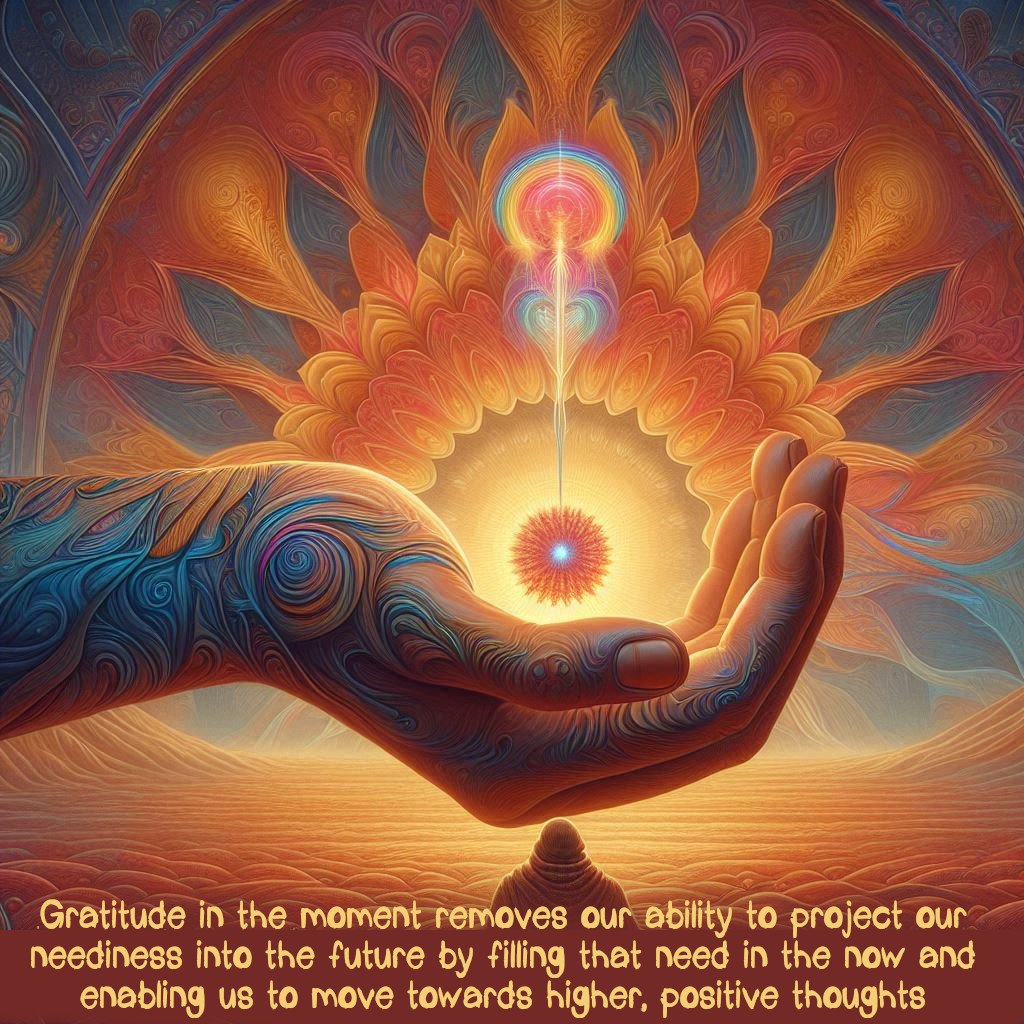
Gratitude in the moment removes our ability to project our neediness into the future by filling that need in-the-now and enabling us to move towards healthier, positive thoughts
Gratitude in the moment
Gratitude in-the-moment, is a conceptual extension of the idea that gratitude as a conscious, positive action, by proposing that the individual should extend their feelings of gratitude into every moment of the day that they experience.
Gratitude, can be a significant and often underappreciated emotion, it can hold the power to transform our present mindset and influence our future outlook.
When we practice gratitude in-the-moment, we engage in a conscious acknowledgment of the positives in our current situation, no matter how small or seemingly insignificant. It allows us to reduce toxicity in our local environment, and turns positivity into a natural, consistent flow.
This act of recognition and appreciation, serves establish a positive relationship with our environment, which will satisfy our immediate emotional needs, which might otherwise manifest as a longing or neediness projected into the future. By fulfilling these needs in the present, we effectively close the gap between desire and fulfilment, allowing us to experience contentment, satisfaction and joy, for each moment we experience.
Peak-Growth
Gratitude in the now-moment is a key element required in order to achieve “Peak-Growth“, where the content of each now-moment is processed within the same now-moment interactive envelope, resulting in minimal stress, anxiety, and trauma. Maximising ones ability to meet each new moment with fresh positivity and curiosity. It is a critical aspect of maximising the effectiveness and focus that ones mind can bring to bear in any new moment. A key aspect of true self-esteem, confidence, and trust.
Contentment as a foundation
Gratitude in the now-moment, as mentioned, by finding ways of thinking that interpret each new experience as being positive and beneficial, removes concerns, fears and worries, that would tend to make us ruminate about future implications, and overall, this brings contentment.
This contentment then acts as a foundation upon which we can build more complex and positive thoughts. Instead of being preoccupied with what we lack or what we fear we might need later, gratitude anchors us in the now, freeing our mental resources to pursue growth and improvement. It’s akin to filling a void within ourselves that might otherwise consume our thoughts with worry about future deficiencies.
Moreover, gratitude has a cumulative effect. The more we practice it, the more natural it becomes, and the easier it is to find things to be grateful for. This creates a positive feedback loop, where gratitude begets more gratitude, and our mindset shifts from one of scarcity to one of abundance. In this state, we are more likely to notice opportunities and blessings, which might have otherwise been obscured by a preoccupation with future needs.
Impact on the Window of Tolerance
Carl Rogers introduced the concept of the “Window of Tolerance“, as a way of understanding how our inner-resources, can ebb and flow, based on positive and negative “events” as each person travels through life. In effect, he described a leaky bucket, filled with liquid “resilience“, our strength, energy and vitality, that keeps us away from the bottom of the bucket. If the liquid drains to the bottom, the panic, fight or flight, or even existential crisis may overwhelm the individual, and they have some form of traumatic shock.
When we wake up, for example, our Window of Tolerance will be at a certain level, good things such as self-care and meals will tend to lift that level, but background toxicity and challenges that we encounter over the course of the day will tend to lower that level, bringing us closer to that scary level of fight-or-flight.
The level of our tolerance or resilience, therefore, can be seen to be a zig-zag that lifts and rises as we progress through each moment of the day, and depending on the balance of positive and negative moments, then we will see a trend, of that window, rising, falling, or staying level.
Imagine, then, what would happen, if one were to create a way of automatically adding some positivity, into each moment, via gratitude? In effect, one would be able to take a day with an overall negative trend, and apply an automatic positive bias to take that trend into positivity. This is what gratitude in the moment can do.
How does one achieve gratitude in the moment?
Having gratitude is one thing, and our page on it explains how to find and express gratitude, as something you might do as an occasional practice, perhaps a few times a day, and more as part of a focussed break. However, it is clear that trying to achieve some level of gratitude for everything that happens to you, constantly, is not always going to be easy: Distractions, environmental toxicity, your own thought patterns, will all work to cause you to forget that conscious act of remembering to give gratitude. In addition, who has time for that!!!
This is where you need to remember that the human mind is the automating mind, and we can learn to hold that constant gratitude as a background task. Therefore, what you need to find, is your own “gratitude mindset”, a natural frame of mind, usually curious and interested, that will naturally entertain thought of gratitude.
In fact, it will seek out gratitude, whenever there is a quiet moment. Then, you introduce that mindset, and have that appreciation, into your moment, at increasingly regular intervals. You will also need to be mindful, and identify obstacles to your gratitude, and “change your mind”, find the source of that negativity that you are projecting onto that “thing”, and correct that issue.
Over time, less time than you might think, you will find that seeking gratitude in the moment can become so automatic, that every moment, opens, with a little bit of joy, and all you have to do, is do what you do, in that joyful, gracious way.
Effect on relationships
Alongside the task of finding “reasons to be cheerful”, and have gratitude for, we also need to think about our relationships with others, and how it is often these that can become a sticking point, in terms of allowing us to feel grateful.
This is often because we have conditioned ourselves into some form of pessimism, that creates a lacking of trust, and also, a tendency to exaggerate any negative feelings. We like to think of relationship with others, as a dance, and that sometimes, we get our Happy Dance, wrong. We tend to look for all the bad news, first, and we tend to mistrust everyone, and this is going to need correcting, too. You can learn more, by looking at our article on How to Think Yourself Happy.
If we get our happy dance right, then this can be a source of gratitude that can strengthen our relationships with others. When we express genuine appreciation for the people around us, we strengthen our bonds with them and encourage a mutual exchange of positive regard. This can lead to a more supportive and nurturing environment, both for ourselves and for those we interact with.
In essence, gratitude in-the-moment acts as a fulcrum, constantly balancing our emotional state and propelling us towards a more optimistic and proactive approach to life. It allows us to appreciate what we have, diminishes our anxieties about what we don’t, and opens us up to a world of positive possibilities. By focusing on the present and acknowledging the value of now, we set ourselves on a path towards a more fulfilling and thoughtful existence.




0 Comments